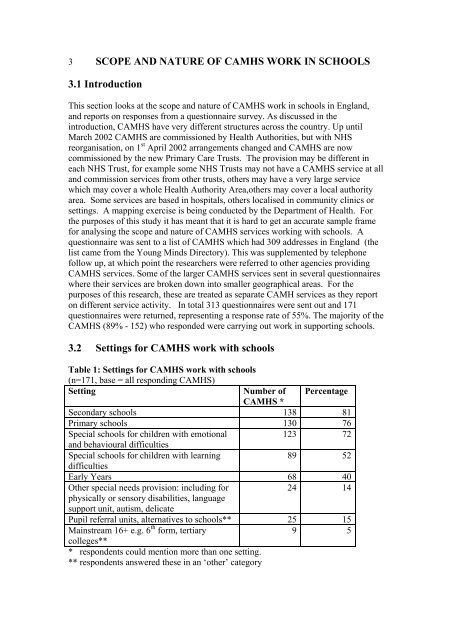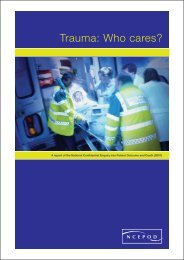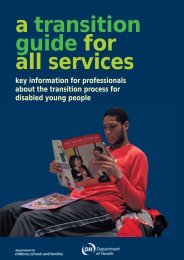(CAMHS) and Schools - London Health Programmes
(CAMHS) and Schools - London Health Programmes
(CAMHS) and Schools - London Health Programmes
Create successful ePaper yourself
Turn your PDF publications into a flip-book with our unique Google optimized e-Paper software.
3 SCOPE AND NATURE OF <strong>CAMHS</strong> WORK IN SCHOOLS<br />
3.1 Introduction<br />
This section looks at the scope <strong>and</strong> nature of <strong>CAMHS</strong> work in schools in Engl<strong>and</strong>,<br />
<strong>and</strong> reports on responses from a questionnaire survey. As discussed in the<br />
introduction, <strong>CAMHS</strong> have very different structures across the country. Up until<br />
March 2002 <strong>CAMHS</strong> are commissioned by <strong>Health</strong> Authorities, but with NHS<br />
reorganisation, on 1 st April 2002 arrangements changed <strong>and</strong> <strong>CAMHS</strong> are now<br />
commissioned by the new Primary Care Trusts. The provision may be different in<br />
each NHS Trust, for example some NHS Trusts may not have a <strong>CAMHS</strong> service at all<br />
<strong>and</strong> commission services from other trusts, others may have a very large service<br />
which may cover a whole <strong>Health</strong> Authority Area,others may cover a local authority<br />
area. Some services are based in hospitals, others localised in community clinics or<br />
settings. A mapping exercise is being conducted by the Department of <strong>Health</strong>. For<br />
the purposes of this study it has meant that it is hard to get an accurate sample frame<br />
for analysing the scope <strong>and</strong> nature of <strong>CAMHS</strong> services working with schools. A<br />
questionnaire was sent to a list of <strong>CAMHS</strong> which had 309 addresses in Engl<strong>and</strong> (the<br />
list came from the Young Minds Directory). This was supplemented by telephone<br />
follow up, at which point the researchers were referred to other agencies providing<br />
<strong>CAMHS</strong> services. Some of the larger <strong>CAMHS</strong> services sent in several questionnaires<br />
where their services are broken down into smaller geographical areas. For the<br />
purposes of this research, these are treated as separate CAMH services as they report<br />
on different service activity. In total 313 questionnaires were sent out <strong>and</strong> 171<br />
questionnaires were returned, representing a response rate of 55%. The majority of the<br />
<strong>CAMHS</strong> (89% - 152) who responded were carrying out work in supporting schools.<br />
3.2 Settings for <strong>CAMHS</strong> work with schools<br />
Table 1: Settings for <strong>CAMHS</strong> work with schools<br />
(n=171, base = all responding <strong>CAMHS</strong>)<br />
Setting<br />
Number of Percentage<br />
<strong>CAMHS</strong> *<br />
Secondary schools 138 81<br />
Primary schools 130 76<br />
Special schools for children with emotional<br />
123 72<br />
<strong>and</strong> behavioural difficulties<br />
Special schools for children with learning<br />
89 52<br />
difficulties<br />
Early Years 68 40<br />
Other special needs provision: including for<br />
24 14<br />
physically or sensory disabilities, language<br />
support unit, autism, delicate<br />
Pupil referral units, alternatives to schools** 25 15<br />
Mainstream 16+ e.g. 6 th form, tertiary<br />
9 5<br />
colleges**<br />
* respondents could mention more than one setting.<br />
** respondents answered these in an ‘other’ category

















